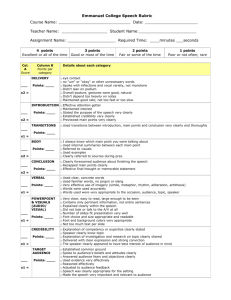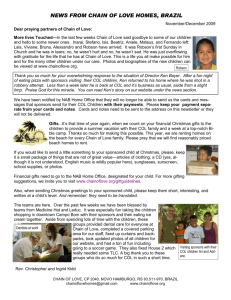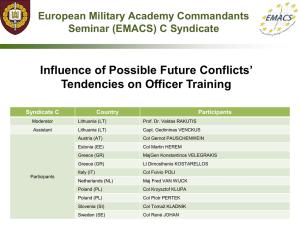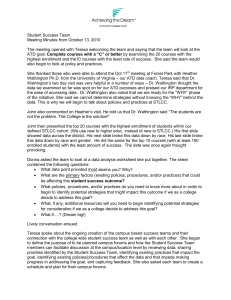ATD Success Team Jan 19 Agenda 3:00 – 5 pm
advertisement
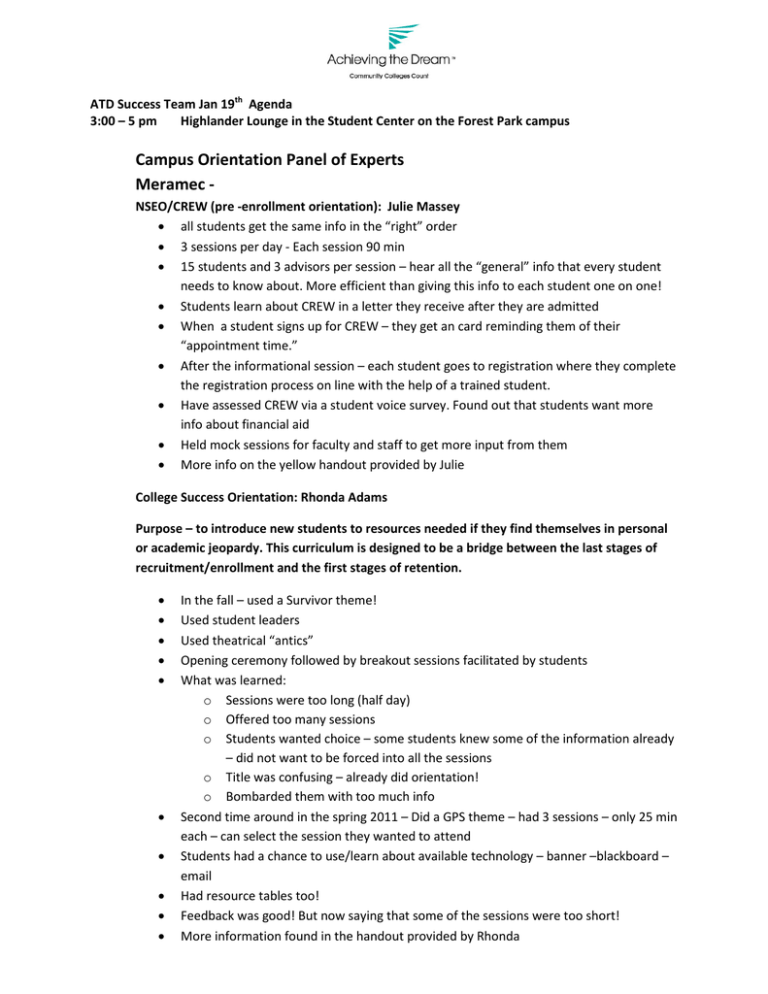
ATD Success Team Jan 19th Agenda 3:00 – 5 pm Highlander Lounge in the Student Center on the Forest Park campus Campus Orientation Panel of Experts Meramec NSEO/CREW (pre -enrollment orientation): Julie Massey • all students get the same info in the “right” order • 3 sessions per day - Each session 90 min • 15 students and 3 advisors per session – hear all the “general” info that every student needs to know about. More efficient than giving this info to each student one on one! • Students learn about CREW in a letter they receive after they are admitted • When a student signs up for CREW – they get an card reminding them of their “appointment time.” • After the informational session – each student goes to registration where they complete the registration process on line with the help of a trained student. • Have assessed CREW via a student voice survey. Found out that students want more info about financial aid • Held mock sessions for faculty and staff to get more input from them • More info on the yellow handout provided by Julie College Success Orientation: Rhonda Adams Purpose – to introduce new students to resources needed if they find themselves in personal or academic jeopardy. This curriculum is designed to be a bridge between the last stages of recruitment/enrollment and the first stages of retention. • • • • • • • • • • In the fall – used a Survivor theme! Used student leaders Used theatrical “antics” Opening ceremony followed by breakout sessions facilitated by students What was learned: o Sessions were too long (half day) o Offered too many sessions o Students wanted choice – some students knew some of the information already – did not want to be forced into all the sessions o Title was confusing – already did orientation! o Bombarded them with too much info Second time around in the spring 2011 – Did a GPS theme – had 3 sessions – only 25 min each – can select the session they wanted to attend Students had a chance to use/learn about available technology – banner –blackboard – email Had resource tables too! Feedback was good! But now saying that some of the sessions were too short! More information found in the handout provided by Rhonda Steps to Success: Kim Fitzgerald – offered AFTER classes begin! Carrots offered to attend • • • Offers information sessions to both students and faculty and staff First 3 – 6 weeks very important Steps to Success is in three parts (The flyer describing all of these offerings has been provided to the faculty early enough that they could include this with their syllabus. o Getting connected – have people who can help students with technology – banner, blackboard, email o Find Resources! - Passport to success (info at tables in the cafeteria about free resources) and Club days (Info at tables in the cafeteria about clubs!) o Seminars for Success – 14 different seminars offered a number of times during the first 6 weeks of the semester. The flyer listing these seminar o Flyer of information was provided Florissant Valley CREW Credit reenrollment workshops - Laura Sterman • • • • • Small groups of students each with a provided laptop computer Learn about terms – like prerequisites etc.. Use the on-line schedule - Assist them in building their schedule for the semester Leave with a NEXT steps guide for their major and what courses they need to take Express advisor completes their financial aid Orientation – occurs after enrollment but before classes - Dwayne Morgan • Recruit students to attend orientation by getting names of those registered from TESS • Use peer leaders o Peer leaders contact students – tele-counseling… o Peer leaders use a provided script • Folder of information – provided by Dwayne Morgan. Orientation entails: o the peer leaders tell their story o Guided viewing sheet to go along with a video o Shift into gear – interactive information table o Expected classroom behavior – presented by faculty o Road to success – college rights and responsibilities o Peer leaders explain courtesy rules o Review the class schedule and explain it o Guided tour o Activate their student email – student resource room o Assessment piece – students want to have more time with the faculty and more weekend orientations Forest Park and Wildwood – Joanie Friend • Shared a powerpoint from FP – their orientation – offered more times than in the past and occurs right after the student takes their assessment test. • Flow Chart • Shared a WW handout – shows how they do orientation – WW uses breakout sessions like Meramec but the attendance at each New student orientation session is around 100 at a time. WW does not offer these sessions as often as Meramec. • WW also offeres a hands on technology session too! • Joanie spoke about the retention recommendations – new student enrollment sessions – student success orientations – COL 020 course. Advisors working with small groups to give basic info and then working one on one for registration and planning Questions/Comments from the Collegewide ATD Student Success Team • • • • • • • • • • • • • • • • Orientation does exist for some of the disciplines – like art, culinary, nursing Kinds of Orientation o Pre-enrollment o Student success orientation – right before classes begin o FYE – course Timing of much of the information is VERY important Other schools – tell students – here is your next step and schedule them before they leave… Challenges – new students expected to attend “before class” orientation – but because students register so late – they miss it. Do we need to have orientations during the first week of class? Tough to get the transfer students – think they have already been through an orientation Another challenge – students can take the placement test – never see an advisor – enroll on line and never come to campus before classes – so they don’t come to orientation.. Challenge – so many students come at the last minute! Some issues are best addressed during the semester in a credit class which we can force them to attend!!! Another challenge – the staffing of the orientation, Rooms to hold orientation. The financial aid process is a challenge – after each student registers – they have to get an audit and then come back to advising – different process at different campuses … A course cost our students money – seems unfair to charge students to find out what services they have available to them. Focus on Success event at FV is a “mini” orientation course… Presently have around 20% of our new students attending orientation before class – preaching to the choir at Meramec. FV is reaching closer to 50%. Verbiage – titles of everything we are offering – confusing! Can faculty and staff reinforce what is happening at pre-class orientations? Need to be careful when we use the word “required.” Need to be able to operationalize Need to make an orientation course a prerequisite and/or part of a degree program so it would come up in their degree audit. COL/FYE Panel of Experts History • • • Lillian Seese Col 020 – been working on task forces since 1983 recommending this course for students in 2 or more developmental classes. Tried to keep curriculum consistent, different text for each campus. Coordinators responsible for teacher professional development. Started common teacher training for this course. Teachers must have passion for dev. Ed students. 11 people on ATD team at MC teach Col 020. Lillian told the story about her COL class. She spent lots of time on goal setting, 18 of 22 had goal to complete English paper and turn it in on time. 16 forgot about the paper due by the next week. Students need a whole semester to transition to being college ready. • • • • • • • • • • • • • • • • • NADE self study in Col 020 done, 1530 Fall 07 tested into 3 or more dev ed, persistence higher for students taking the course. Additional sections needed if required, 18 FV, 24 FP, 12, M, 2 WW. Huge commitment in staffing and space if class required for students testing into 2 or more developmental ed classes. COL 020 proved to be a success for students in developmental education for two or more classes or three or more classes in Fall 2007. George Wasson says delivery has changed since 2007, peer leaders are not assigned to all sections at MC, FV doesn’t have peer leaders, FP does not have peer leaders. Do we have data on the impact of peer leaders? George not sure what is being done consistently in all sections. Now offering more training for all instructors with feedback sessions at the end of the session Collegewide pre and post assessment is administered to each section of COL 020 There exist a Collegewide course profile Have different book at each campus Each campus coordinator in charge of PD for the faculty teaching COL 020 at their campus Julie Copp and Lillian Seese created a common teacher training. Rolled it out last summer. Need faculty who enjoy teaching dev ed students 8 goals covered in depth in the class. ( see handout) Need to add designing a career and academic plan as #9. Look at the data in the handout – students who take the class at STLCC persist at a higher rate than those who do not take the course. Students feel that they learn more about each topic presented during the course. (This conclusion came from the pre and post assessments given to the students taking the course) Talked about on line orientation – not a good idea. FV does offer a college orientation course for high school Access students – a 2 credit hour course. The course covers how to use the Access office when they come to FV. (Paid for by the Ferguson/Florissant School District.) Have offered college orientation for specific groups – like athletes… Art is thinking about a specific section for art students. Now are offering training for faculty. What is consistent on all campuses? Col 100 is on the books – not taught very much! IDS 101 – Gen Ed “orientation” course – Chris Stephens • • • • • • Gen Ed collegewide committee is looking at the program rolled out in 2003 – how can it be improved? Need to increase the degree completion Dilemma – we have not been meeting the students gen ed needs Need an academic plan to make this happen Is Gen ed achieving the goals set out by the college? Have identified problems: o Students don’t understand the program – we need to do a better job communicating what it is o Faculty and staff do not really understand the program and its transferability… o what are the orientation goals and responsibilities of the Gen Ed program? o o o o o o o o Need to look at the cornerstone course – mainly orientation? Mainly valuing? If a student has taken Col 020 – how does the cornerstone course fit for them? Those who have not taken Col 020 – does the cornerstone do the trick? What writing are we doing right now and what writing skills do the students need? – need to figure this out before deciding if they need Eng 101 and Eng 102. Questions also about speaking and writing intensive courses. Need PD to help faculty with speaking and intensive courses. Questions – do we need Eng 102? If so – then maybe we ditch the cornerstone… How does this fit with COL 100 or COL 020. Questions/Comments from the Collegewide ATD Student Success Team • • • • • • • • • • • Entrance requirement scores are going down and will cause our “college – ready” students to be needier… (going to Compass versus Accuplacer and lower ACT scores for English and Reading…) How many groups are already offering orientation to specific groups? Orientation as part of Eng 101, Oral Com 101 and IDS 101?? Require faculty to teach Col 020?? Modularize Orientation? Insert it into specific courses? Pairing classes – looking at Orientation more holistically Cornerstone was the gen ed committees attempt at an FYE course. Students are coming at us from all directions – need many solutions… Need more PD and the credentials of those who teach them and people who WANT to teach them!!! Could we have a student success center where students are required to spend 2 hours a week or something like that… Issues to consider: Staffing, credentials, professional development and support, Course shell, learning objects to facilitate adjuncts teaching the course, alignment with student affairs, use of existing staff such as counselors and student affairs during their regular day. Space utilization, target populations, new to college, transfer student, financial aid alignment, degree audit, relationship of Col 020, 100 level, Cornerstone, flow avoid redundancy. ATD Team members asked to write their answers to the following questions on the back of their agenda and give to Teresa: 1) What questions/issues around Orientation and/or FYE must be addressed? 2) Who are the Orientation/FYE experts that need to be part of the implementation team? 3) 4:55 – closing – next meeting will be on Jan 26th from 3 – 5 pm in TC 110/116 on the FV campus. The topic of discussion will be best practices/models for advising students – like: intrusive advising, ALP, retention coaches, faculty advising, department advising, AAMI, TRIO, COL, high school outreach, what else???? 4) Spring Semester meetings (all are on Wednesdays from 3 – 5 pm) Feb 2 Feb 16 Mar 2 Mar 23 M – Confluence Room – topic: Developmental Education – STLCC history/how it is today/ NADE WW – Multipurpose Room – topic: Developmental Education Innovations at STLCC FP – L007 FV – TC 110/116 Issues for the Strategy Team: 1) Operational Definitions – What do we call each experience BEFORE classes begin? What do we call each experience AFTER classes begin? 2) Space/geopgraphy 3) Staffing 4) New to college vs. New to STLCC 5) Flow of the process for Financial Aid 6) Pre- semester vs. in semester options 7) Structure 8) Engagement of faculty and staff 9) “requirement” – operationalizing – need to make the course/experience part of a degree or a prerequisite in order to be part of a degree audit 10) Relationships of COL 020, COL 100, IDS 101, ENG 101 and COM 101

